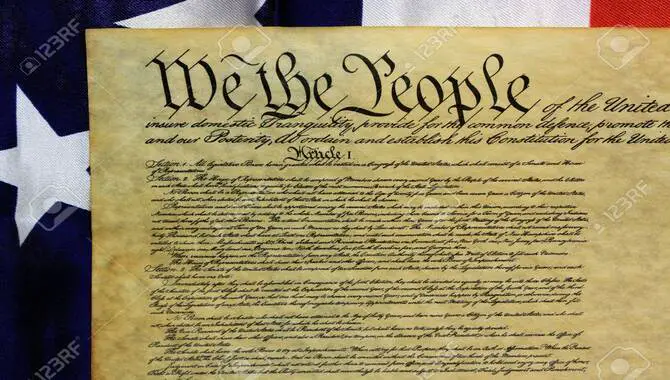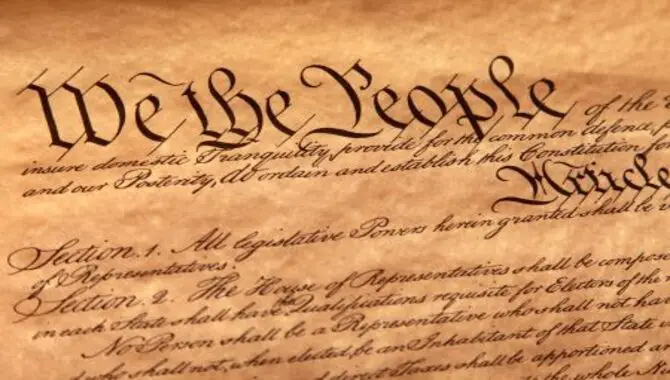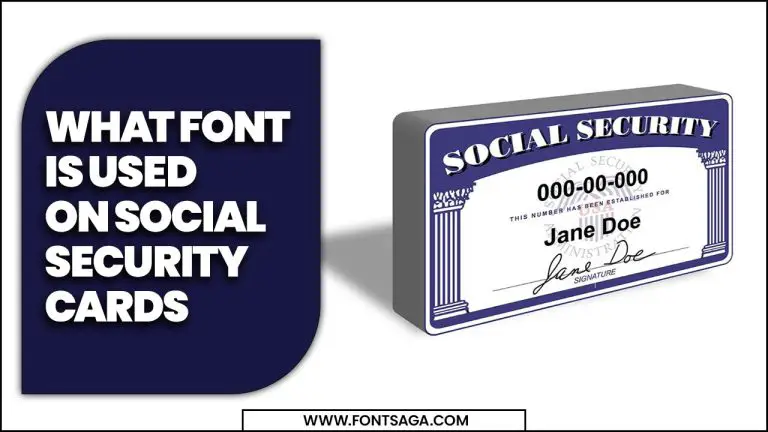The font of the Constitution is not widely known, but it is not intentionally kept secret. As the Constitution was originally handwritten, the font choice was insignificant. The emphasis is on the content and principles rather than the font used.
Have you ever wondered what font is the Constitution written in? It’s a question that has puzzled many for a good reason. There is little information available to the public about the font of the Constitution, which shrouds it in secrecy. We will unveil this secret and answer all your burning questions about the font of the Constitution. Get ready for an intriguing journey into typographic history.

What Font Is The Constitution Written In? Answered

The question what font is the constitution written in? The writers of the United States Constitution did not use a specific font for writing it. Several individuals, including Jacob Shallus, who served as the engrosser of the Constitution, handwritten it instead.
People used the handwriting style known as “copperplate script” in the original document, which was a popular style of handwriting during the time period.
People often used this elegant and ornate script for official documents and important legal texts. You can use fonts inspired by copperplate script to create a similar aesthetic to the handwriting style of the Constitution, but no specific font exactly replicates it.
The Original Handwritten Constitution
The writers of the original Constitution document did not use a specific font. Instead, someone carefully transcribed it using pen and ink, following the graceful Copperplate script.. This exquisite handwriting style, popular in the 18th century, features flowing lines and elaborate flourishes.
Jacob Shallus, a clerk for the Pennsylvania General Assembly, was responsible for the meticulous transcription of the final Constitution version in Copperplate script. While there are no exact replicas of the handwritten Constitution font, fonts that draw inspiration from the Copperplate script allow for a similar visual representation.
The Font Of The 1787 Constitution

The font used in the 1787 Constitution of the United States was not a specific typeface like we think of today. Rather, someone handwritten it in a style known as Copperplate or Engrossing script.
This calligraphy style, popular during the 18th century, featured elegant and elaborate letterforms that emphasized the document’s formality and prestige. Using the Copperplate script ensured that the Constitution would be visually striking and an important representation of the new United States.
The Significance Of The Font Choice
The significance of the font choice in the Constitution lies in its historical and aesthetic value. The framers of the Constitution wrote it in “Copperplate script,” an elegant and flowing handwriting style popular in the 18th century, instead of using a specific font.
Jacob Shallus, a clerk for the Pennsylvania General Assembly, was responsible for hand-writing the final version. Although no digital font can perfectly replicate the Copperplate script, font designers have created fonts inspired by it. These fonts contribute to the visual impact and preservation of the document.
The Legacy Of The Constitution’s Font

The handwriting style used in the original handwritten Constitution of the United States, known as “Copperplate script” or “Engrossing script,” reflects the importance and solemnity of the document.
The font used in the Constitution is Caslon, a serif typeface popular in the 18th century, which gives it a traditional and authoritative appearance. The font choice, Caslon, contributes to the visual impact and preservation of this significant and historical document.
The Evolution Of The Constitution’s Font
The evolution of the font used in the Constitution showcases the document’s journey from its original handwritten form to modern reproductions. Jacob Shallus, an American scribe, carefully penned the original Constitution using a calligraphy script known as Copperplate.
During the 18th century, people favored this elegant handwriting style to symbolize the gravity of important documents. As the Constitution underwent transformations and reproductions, the font utilized varied over time.
Modern printings and digital representations often adopt fonts like Times New Roman or Garamond to replicate the original handwritten text. The evolution of the Constitution’s font reflects its enduring legacy and the ongoing efforts to preserve its historical significance.
Why It Is Important To Know The Font Of The Constitution

The font choice in the Constitution has far-reaching implications, offering glimpses into its historical context and design choices. Knowing the font adds authenticity to replicas and enhances the document’s accessibility and readability.
Discovering the font used in the Constitution is a fascinating journey into the typography world and this symbolic document’s cultural significance. Unlocking this secret allows for a deeper appreciation of the craftsmanship and design choices that shaped our democracy.
How The Font Change Affects Our Democracy
The font changes throughout the evolution of the Constitution have had a significant impact on our democracy and the way we perceive and interpret our foundational document. Originally written in the elegant “Penman Old Style” font, the Constitution’s typeface represented the values and aesthetics of its era.
However, as time went on, font changes shaped our understanding and application of constitutional principles. Today, with the transition to digital fonts, the Constitution has become even more accessible and legible, ensuring that democratic ideals are easily comprehensible to all.
These font transformations are not merely aesthetic but hold implications for the credibility and authority of legal documents, including the Constitution.
Conclusion
Ultimately, what font is the Constitution written in? The font used in the Constitution holds historical significance and reflects the values and ideals of the time. It is a symbol of our democracy and the foundation of our nation.
Understanding the font used in the Constitution allows us to appreciate its rich history and its impact on our society. It reminds us that every word and every detail matters when it comes to shaping our government and protecting our rights.
Frequently Asked Questions
What Is The Font For The Constitution In Word?
No one initially wrote the Constitution in a specific font in Word. People used handwritten type for constitution manuscripts. If you want to create a document resembling the Constitution, use classic serif fonts like Times New Roman or Garamond. However, remember to prioritize the content and meaning of the Constitution over its font style.
What Is The Best Font For The Constitution?
Traditionally, people use “Garamond,” a classic serif font that is easily read and visually appealing to write the Constitution. However, people commonly use fonts like Times New Roman and Arial for legal documents.
Is Constitution Written In Cursive?
No, people did not entirely write the Constitution in cursive. The original handwritten version used a combination of cursive and print writing. However, the final printed version is in a clear, legible typeface. People wrote in cursive handwriting more often during the time when they wrote Constitution.
What Are The Best Fonts For Legal Documents?
People commonly prefer fonts like Times New Roman, Arial, and Calibri for their readability and professional appearance when dealing with legal documents. Choosing a clear and legible font that can be easily read in print and digital formats.
What Font Or Script Was The Constitution Written In?
The writers of the United States Constitution wrote it in a typeface called “Penman Old Style,” which mimics handwriting with a quill pen. We chose this font to give the Constitution a traditional and formal look. Its use has also influenced the design of other significant documents and legal materials.











Leave a Comment